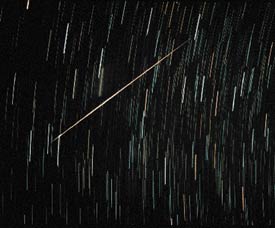
A bright meteor streaks past the Andromeda Galaxy (fuzzy trail just above the meteor's center).
Courtesy J. F. Funderburg.
This is a so-so year for observing the annual Orionid meteor shower. A fat crescent Moon will be high in the sky during the predawn hours when the activity peaks on October 21st. If the sky were fully dark, this shower would produce about 15 swift meteors per hour, identifiable because their paths, extended backward, would intersect just north of Betelgeuse. A few Orionids may appear as early as the start of October and as late as the first week of November.
Use our interactive sky chart to see the appearance of the sky at 2:00 a.m. daylight saving time (from 40° north latitude) during the peak morning of the
Orionid meteor shower.
On the chart, the shower name and symbol are visible in both windows. Click on the "change" button to alter either the date and time or viewing location displayed by the chart.
Although not a strong or spectacular shower, the Orionids have one significant claim to fame: the particles come from the reigning king of comets, Halley. Earth passes near the long, looping orbit of Comet Halley twice per year, and each approach peppers our atmosphere with dust strewn along Halley's orbit. Yet, despite their impressive lineage, the Orionids in October (and the Eta Aquarids in May) are not particularly well known.
 0
0
Comments
You must be logged in to post a comment.